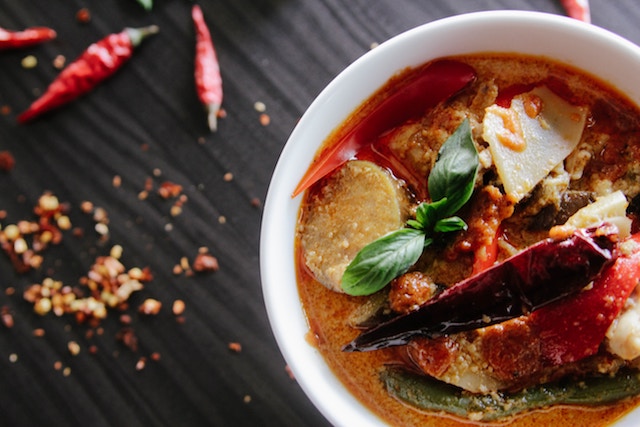I was chatting with a friend the other day and they mentioned they’d just had Indian food for the first time ever.
The first time ever?! I could not believe it.
I realized then how spoiled I’d been growing up. Being from England, Indian food is almost (emphasis on the almost) British—and we ate an awful lot of it in my house.
Indian food has been a British staple for centuries. The first documented Indian restaurant opened in the U.K. in 1810, although curries were already available in some of the capital’s trendy coffee houses, and as early as 1747 Indian recipes were appearing in cookbooks such as Hannah Glasse’s The Art of Cookery. Early recipes were extremely mild compared to the modern offerings, more often flavored with herbs than spices.
The trickle of Indian cuisine to the rest of the world turned into a flood in 1858, when India became part of the British Empire. Expats who enjoyed the fantastic cuisine in India brought back recipes and attempted to make curries in their own homes.
Queen Victoria’s keen interest in the cuisine then added even further to British enthusiasm for it. She was fascinated by India and had mainly Indian staff.
According to food historians, curry was on the menu almost daily. The word spread, and the upper and middle classes latched on to this “fad” and started to include it in their meals more frequently.
An excerpt from the Victorian cookbook Modern Domestic Cookery reads: “Curry, which was formerly a dish almost exclusively for the table of those who had made a long residence in India, is now so completely naturalized that few dinners are thought complete unless one is on the table.”
After Word War II, a large number of Indians, and especially Bangladeshis, emigrated to England, and brought with them their recipes and cooking skills. They set up their own restaurants, originally to cater for their brethren, but soon saw that there was a market for the locals too.
And so the curry culture of Britain boomed.
In England, chicken tikka masala is by far the most popular Indian dish—it makes up for one in every seven curries served in the country. The dish is arguably a uniquely British one. Popular belief is that a Scot sent back his chicken curry stating the chicken was too dry. The chef apparently tipped a can of tomato soup and some yoghurt in it, and so the chicken tikka masala was born!
So, as a Brit, you can understand how aghast I was that this friend had never eaten Indian food before. (Probably a bit like we Brits having never had Mexican before.)
I beg of you, lovely Americans, give curry a go! It really is one of the most delicious foods in the world.
Start your curry adventure with this easy to make, healthy lentil dish.
Indian Curry with Vegetables
Ingredients
1 cup of orange split lentils
1 cup of chopped cauliflower
1 cup of chopped bok choy
1 cup of chopped mushrooms
1 tsp turmeric
1 tbsp mustard seeds
4 cups of vegetable stock
Paste ingredients
1/2 cup chopped cilantro/coriander
1/4 cup chopped mint
2 fresh green chilis
11/2 tbsp tamarind paste
2 cloves black garlic (normal garlic is fine if you don’t have black)
Pinch of salt
Oil for frying
Method
1. Place all the ingredients for the paste into a small blender and blend until a thick paste has formed.
2. Heat 2 tbsp of oil in a pan and add the turmeric and mustard seeds when the oil is hot. Stir and cook for two minutes to release the flavours. When the mustard seeds start to “pop,” add the paste, stir it around, and then add the lentils. Stir the lentils in and around the paste, and then add the vegetable stock.
3. Cook the lentils until they are soft (about 25 minutes), and then add the vegetables. Cook for an additional three minutes and then serve it up!
Not only does this dish come bursting with flavours, it also comes with a virtual halo—it’s so nutritious and good for you. Win-win!
If you want to add some extra protein, add some peeled, uncooked prawns/shrimps two minutes before serving. Cook until they have turned pink (about two minutes).
~
Author: Claire Preen
Image: Elli O./Unsplash
Editor: Emily Bartran
Copy Editor: Nicole Cameron
Social Editor: Danielle Beutell


 Share on bsky
Share on bsky



Read 0 comments and reply